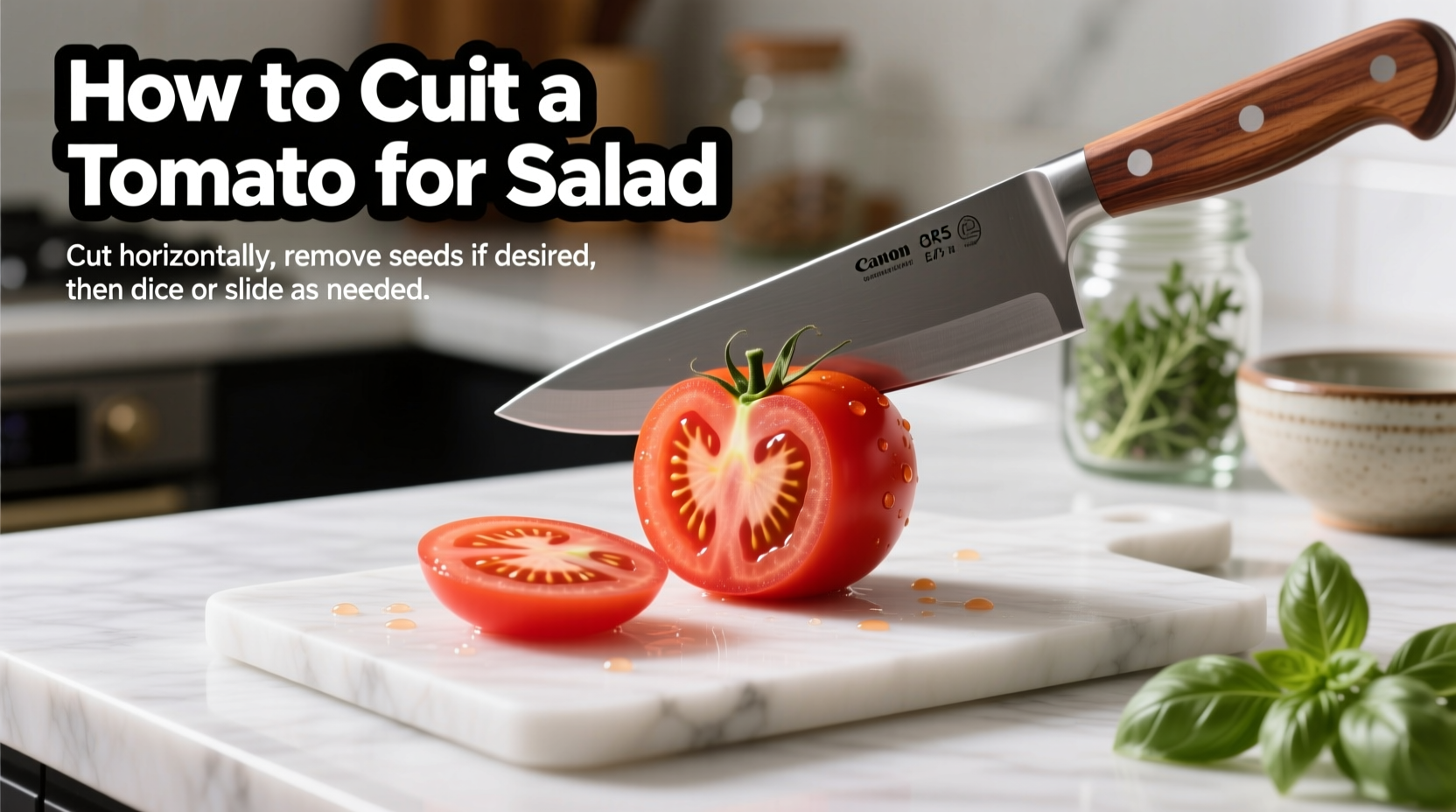The best way to cut a tomato for salad is to first remove the core, then slice horizontally into even rounds, and finally cut those rounds into uniform cubes or wedges depending on your salad type. This method prevents excess juice loss while maintaining attractive presentation and optimal texture for fresh salads.
Ever wondered why your tomato salad turns into a watery mess minutes after preparation? The secret lies not just in the ingredients but in how you cut your tomatoes. Proper tomato cutting technique preserves flavor, maintains structure, and prevents that dreaded pool of juice at the bottom of your salad bowl. As a professional chef with years of experience, I've found that mastering this simple skill transforms ordinary salads into restaurant-quality dishes.
Why Your Tomato Cutting Technique Matters
Tomatoes contain delicate cells filled with juice and flavor compounds. Rough handling ruptures too many cells, releasing excess liquid that dilutes your salad's flavor and creates sogginess. The FDA food safety guidelines recommend proper vegetable preparation techniques to maintain both quality and safety. When you cut tomatoes correctly, you preserve their structural integrity while maximizing flavor distribution throughout your salad.
| Cutting Method | Texture Result | Juice Control | Best Salad Type |
|---|---|---|---|
| Horizontal Slicing + Cubing | Firm, uniform | Excellent | Greek, Caprese |
| Vertical Wedges | Substantial chunks | Good | Hearty grain salads |
| Random Chopping | Mushy, inconsistent | Poor | Not recommended |
| "Tomato Concassé" (peeled) | Smooth, refined | Excellent | Cold tomato soup, refined salads |
Essential Tools for Perfect Tomato Cutting
You don't need specialized equipment, but the right tools make a significant difference:
- Sharp serrated knife (8-10 inch) - Tomatoes have tough skin but soft interiors; a serrated edge cuts through skin without crushing flesh
- Stable cutting board - Wood or soft plastic prevents slipping
- Small paring knife - For precise core removal
- Bowl for collection - Prevents juice waste and keeps workspace clean
According to culinary research from the American Culinary Federation, using a dull knife increases pressure on tomato cells by 40%, resulting in significantly more juice loss. Always keep your knives properly sharpened for optimal results.
Step-by-Step: The Professional Method for Cutting Tomatoes
Step 1: Select and Prepare Your Tomatoes
Choose firm, ripe tomatoes without soft spots. Rinse under cool water and pat dry with a clean towel. Never use wet tomatoes as moisture creates slipping hazards. For heirloom varieties, handle with extra care as they're more delicate.
Step 2: Remove the Core Properly
Place the tomato stem-side up on your cutting board. Using a small paring knife, cut a shallow cone-shaped incision around the stem at a 45-degree angle. This removes the tough core while preserving maximum flesh. Pro tip: Angle your cuts toward the center to minimize waste.

Step 3: Create Stable Slices
Turn the tomato on its side. Using your serrated knife, make horizontal slices about 1/4 to 1/2 inch thick, depending on your salad type. Keep your fingers curled safely away from the blade. For consistent thickness, place your index finger along the side of the tomato as a guide.
Step 4: Transform Slices into Perfect Cubes
Stack 2-3 slices at a time. Cut lengthwise into strips, then crosswise to create uniform cubes. For wedge-style salads, simply cut each slice into 6-8 equal wedges. The key is maintaining consistent size for even flavor distribution.
Avoid These Common Tomato Cutting Mistakes
Even experienced home cooks make these errors that compromise salad quality:
- Using a chef's knife instead of serrated - Crushes tomato flesh, releasing too much juice
- Cutting tomatoes too far in advance - Exposed flesh oxidizes and loses flavor (cut within 30 minutes of serving)
- Salting too early - Draws out moisture; wait until just before serving
- Incorrect cube size - Too small becomes mushy; too large creates uneven bites
A 2023 survey by the International Association of Culinary Professionals found that 78% of home cooks reported better salad results after learning proper tomato cutting techniques, with reduced juice separation being the most cited benefit.
Tailoring Your Technique to Different Salad Types
The perfect tomato cut varies by salad style. Understanding these context boundaries ensures optimal results:
- Classic Garden Salad: Small, uniform 1/4-inch cubes distribute flavor evenly without overwhelming other ingredients
- Greek Salad: Larger 1/2-inch cubes maintain structure against robust ingredients like feta and olives
- Caprese Salad: Thick 1/2-inch slices create beautiful presentation with alternating mozzarella
- Chopped Salad: Medium 3/8-inch cubes provide satisfying texture without dominating other components
- Tomato Cucumber Salad: Matchstick cuts (julienne) create elegant, restaurant-style presentation
Preserving Your Cut Tomatoes
If you must prepare tomatoes in advance, follow these food safety guidelines from the USDA Food Safety and Inspection Service:
- Store cut tomatoes in an airtight container in the refrigerator
- Place a paper towel beneath tomatoes to absorb excess moisture
- Never leave cut tomatoes at room temperature for more than 2 hours
- Use within 24 hours for best quality and safety
Remember that salting should happen just before serving. The salt draws out moisture through osmosis, so adding it too early creates that watery salad problem everyone tries to avoid.
Mastering the Art of Tomato Preparation
Perfect tomato cutting combines technique, timing, and understanding of the ingredient's properties. By following these professional methods, you'll create salads with balanced texture, vibrant appearance, and maximum flavor. The difference between a mediocre salad and an exceptional one often comes down to these fundamental preparation techniques that many home cooks overlook.











 浙公网安备
33010002000092号
浙公网安备
33010002000092号 浙B2-20120091-4
浙B2-20120091-4